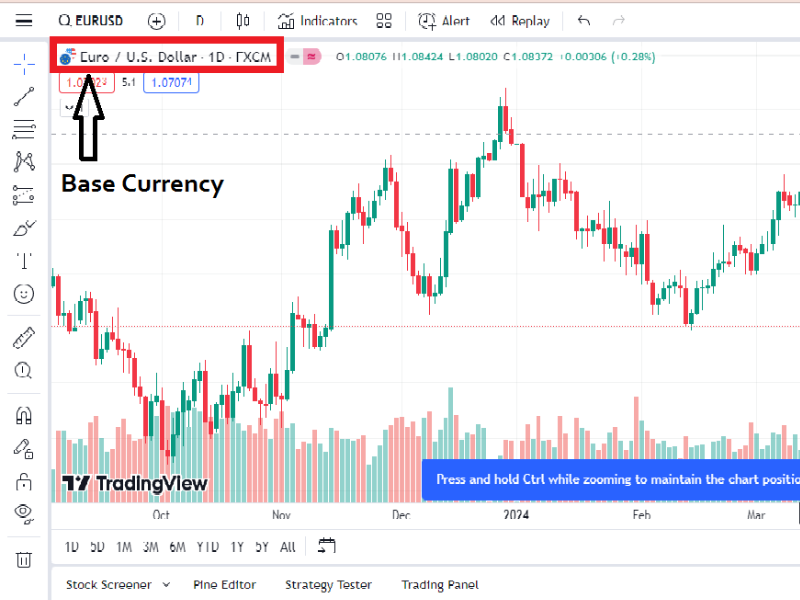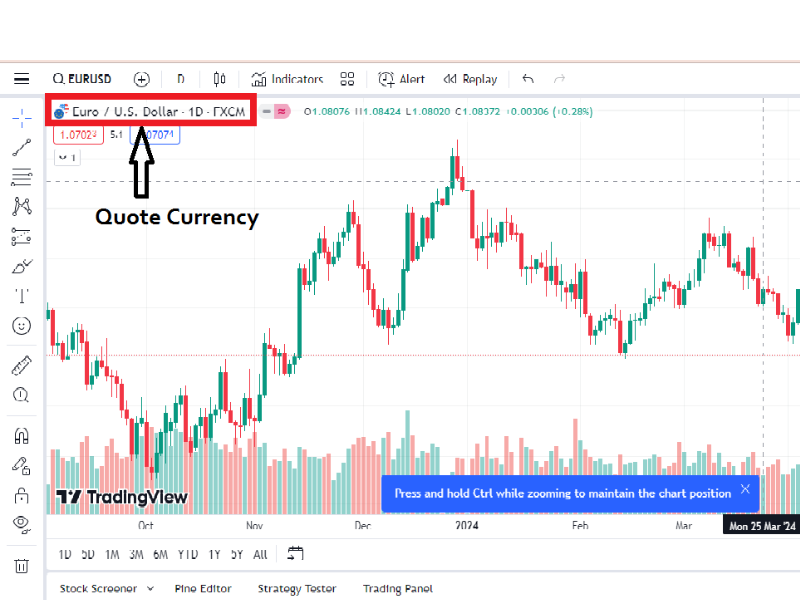
Forex Trading Terminology
Understanding Base and Quote Currencies
Discover how to start forex trading with our comprehensive guide. Forex market which is also called the FX market is a decentralized global marketplace for currency transactions. The global financial market is currently the largest and most liquid market, with an average daily transaction value of around 5 trillion dollars.
There is different currency pair in forex market. Some of the major currency pairs are EUR/USD USD/JPY), GBP/USD, and USD/CHF.
A large number of players are participating in the forex market, including governments, Bank, corporations, financial institutions, traders, speculators, HNI and investors. Due to its global reach, foreign exchange transactions continue to 24 hours a day, five days a week, across several time zones.
Forex markets are open 24 hours a day, five days a week. But it’s devided into four main sessions, which are:
- Sydney – 10 pm to 7 am UTC
- Tokyo – 12am to 9am UTC
- London –8 am to 4 pm UTC
- New York – 1 pm to 10 pm UTC
It is very important that you become familiar with the Forex Trading Terminology or fundamental terms used in forex trading to know how to start forex trading. Though there is lots of things to learn, here is a brief overview of some of the most often used terminology among traders.
Base Currency
- The base currency is the first currency listed in a currency pair (e.g., EUR in EUR/USD).
- It serves as the benchmark against which the value of the quote currency is measured.
- When you buy a currency pair, you are buying the base currency and selling the quote currency.

Quote Currency
- The quote currency is the second currency in a pair (e.g., USD in EUR/USD).
- It shows the value of the base currency in terms of the quote currency.
- When you sell a currency pair, you are selling the base currency and buying the quote currency.

Chart Patterns:
Chart patterns play a crucial role in analyzing market trends and predicting future price movements. They are formed by the movement of prices.
To know more about most profitable chart patterns :
What is Stop Loss and Take Profit in Forex Trading
What is Stop Loss?
Stop Loss: Stop loss is the most important tool according to forex trading terminology in forex trading. A stop loss order is a risk management tool used by traders to limit huge losses on a trade. It is an order placed with a broker to sell a security (in this case, a currency pair) when it reaches a certain price level. The purpose of a stop loss is to automatically close a position and prevent further losses if the market moves against the trader’s position.
How Stop Loss Works:
- Setting Stop Loss: Traders determine a specific price level at which they are willing to accept a loss if the market moves unfavorably. For example, if a trader buys EUR/USD at 1.1200, they may set a stop loss at 1.1150. If the price falls to 1.1150, the stop loss order will trigger, and the position will be closed automatically.
- Benefits of Stop Loss:
- Risk Management: Helps traders control and limit potential losses.
- Emotional Discipline: Prevents emotional decision-making during volatile market conditions.
- Peace of Mind: Allows traders to set predefined exit points, reducing the need for constant monitoring of positions.
- Types of Stop Loss:
- Fixed Stop Loss: A predetermined price level set by the trader.
- Trailing Stop Loss: Adjusts dynamically with favorable price movements, locking in profits while protecting against reversals.
What is Take Profit?
Take Profit: A take profit order is an instruction given to a broker to close a position automatically when the price reaches a specified level of profit. It allows traders to secure gains without needing to monitor the market constantly.
How Take Profit Works:
- Setting Take Profit: Traders set a target price level where they want to exit the trade and realize profits. For instance, if a trader buys EUR/USD at 1.1200, they may set a take profit order at 1.1300. Once the price reaches 1.1300, the take profit order will execute, and the position will be closed at a profit.
- Benefits of Take Profit:
- Profit Protection: Locks in gains before the market reverses.
- Automation: Allows traders to capitalize on favorable price movements without constant monitoring.
- Strategy Execution: Helps maintain discipline by sticking to predefined profit targets.
- Types of Take Profit:
- Fixed Take Profit: A specific price level set by the trader to exit the trade.
- Trailing Take Profit: Adjusts upward with favorable price movements, maximizing profit potential while allowing for continued gains.
Practical Applications of Stop Loss and Take Profit
- Risk-Reward Ratio: Traders often use a risk-reward ratio to assess potential profits relative to potential losses. For example, a trader may set a stop loss at 50 pips below the entry price and a take profit at 100 pips above the entry price, aiming for a 1:2 risk-reward ratio.
- Position Sizing: Determining the appropriate position size based on the distance between the entry price, stop loss, and take profit levels is crucial for effective risk management.
- Partial Close: Traders may choose to partially close a position when the take profit level is reached, while leaving a portion of the trade open to capture potential further gains.
- Multiple Entries and Exits: Using multiple stop loss and take profit orders allows traders to manage complex strategies involving scaling in and out of positions.
Tips for Using Stop Loss and Take Profit Effectively
- Set Realistic Levels: Base stop loss and take profit levels on technical analysis, support/resistance levels, and market volatility.
- Adapt to Market Conditions: Adjust stop loss and take profit levels as market conditions evolve, ensuring they remain relevant to current price movements.
- Monitor Positions: Regularly review and update stop loss and take profit orders based on new information or changing market dynamics.
How to place Stop Loss and Take Profit levels
Determining the most effective levels for Stop Loss (SL) and Take Profit (TP) orders remains a critical topic of forex trading terminology. While setting a Stop Loss is generally seen as straightforward, deciding on an appropriate Take Profit level can be discretionary and sometimes unnecessary. For example, when following market trends, accurately predicting the duration of a trend can be challenging. In such cases, traders often enter the market, set a Stop Loss to manage potential losses, and ride the trend until momentum weakens. Conversely, some traders prefer using Take Profit orders as a proactive part of their strategy.
As mentioned earlier, placing SL and TP orders largely hinges on the trading strategy employed. Various strategies utilize different tools and methods of market analysis. Let’s explore a few popular approaches:
Support and Resistance Levels: Traders analyze charts to identify areas of support and resistance, anticipating potential price reversals. When a price nears a significant level and fails to break through, it establishes a notable support or resistance zone, depending on the price movement direction.
Fibonacci Retracement: Traders utilize Fibonacci retracement levels to pinpoint potential reversal points based on Fibonacci numbers. These levels are often used to set both Stop Loss (SL) and Take Profit (TP) orders.
Trend lines: Trend lines are essential for determining optimal SL and TP levels. Traders draw trend lines at the peaks of price swings to visualize potential price ranges. Depending on the price direction, SL and TP orders are typically placed above or below these trend lines.
Multiple Time Frame Analysis: Some traders employ multiple time frame analysis to identify significant levels for placing SL and TP orders. This method helps mitigate risks associated with volatile market conditions.
Fundamental Factors: According to forex trading terminology economic and political events can trigger significant market movements, potentially hitting SL orders. Many traders regularly consult economic calendars and monitor political developments to avoid placing orders during sensitive periods.
Placement of SL and TP orders is a personal decision tailored to individual trading circumstances. The primary goal is to position them in a manner that maximizes profits while minimizing potential losses.
Precision in adjusting SL and TP orders requires skill honed through experience. It’s crucial to make these decisions within the framework of a well-defined trading strategy rather than impulsively.
